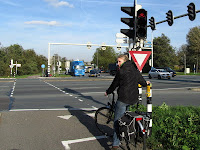.png)

For a while, The Times' campaign thundered on. Over 70 MPs expressed their concerns about cyclist's safety to their minister of Transport and with the Italians being inspired too; it looked like there was even be a pan-European cycling revolution in the making!
Being "Bicycleandtour.com" I'd like to focus on the actual manifesto of the Cities Fit for Cycling campaign, which consists of 8 points:
1. "Trucks entering a city centre should be required by law to fit sensors, audible truck-turning alarms, extra mirrors and safety bars to stop cyclists being thrown under the wheels."


2. "The 500 most dangerous road junctions must be identified, redesigned or fitted with priority traffic lights for cyclists and Trixi mirrors that allow lorry drivers to see cyclists on their near-side."


3. "A national audit of cycling to find out how many people cycle in Britain and how cyclists are killed or injured should be held to underpin effective cycle safety."


4. "Two per cent of the Highways Agency budget should be earmarked for next generation cycle routes, providing £100 million a year towards world-class cycling infrastructure. Each year cities should be graded on the quality of cycling provision."



Regarding the grading of cities on their cycling friendliness; this is a great tool to spark councils into action. The Dutch Cyclist's Federation "Fietsersbond" holds elections for the best Dutch cycling town/city every couple of years. Even in The Netherlands, there are always calls for improvements!
5. "The training of cyclists and drivers must improve and cycle safety should become a core part of the driving test."


6. "20mph should become the default speed limit in residential areas where there are no cycle lanes."


As a rule, many centre lines of roads need to be removed, with wide cycle lanes on both sides replacing it, reducing the truly space for motorists to one central lane in the middle of the road. I explained this Dutch "share the road" principle in my December blog about "a different lick of paint".
7. "Businesses should be invited to sponsor cycleways and cycling super-highways, mirroring the Barclays-backed bicycle hire scheme in London."


8. "Every city, even those without an elected mayor, should appoint a cycling commissioner to push home reforms."
As I pointed out previously, existing cultures within council bodies could be a large obstacle to improvements of cycling conditions. A cycling commissioner in every area could definitely increase the pressure to break these cultures. As I wrote in my November blog, local campaigning could well be the key to change. The proposal to appoint cycling commissioners locally fits very well with this assumption.

What about going for a traffic-calmed cycling holiday with one of my "Cycling Dutchman" guidebooks?
 Cycling in Amsterdam and The Netherlands - The very best routes in the cyclist's paradise makes you travel beyond Dutch cliches like clogs, windmills and the Amsterdam red light district, allowing you to truly explore the lowlands. The book features 1064 kms of routes and has special chapters explaining the unique Dutch cycling-minded traffic rules and its cycle route signage systems; 164 pages, colour, wiro bound, fits in standard handlebar bag, see also http://www.cyclinginholland.com.
Cycling in Amsterdam and The Netherlands - The very best routes in the cyclist's paradise makes you travel beyond Dutch cliches like clogs, windmills and the Amsterdam red light district, allowing you to truly explore the lowlands. The book features 1064 kms of routes and has special chapters explaining the unique Dutch cycling-minded traffic rules and its cycle route signage systems; 164 pages, colour, wiro bound, fits in standard handlebar bag, see also http://www.cyclinginholland.com.


Cycle paths and cycle lanes; the full story!
Sharing the road or segregated cycle paths? Well it is both!

 Dutch style bike rides in the United Kingdom:
Dutch style bike rides in the United Kingdom:


The London - Land's End Cycle Route Book is designed for those who LOVE cycling, but don't like traffic. The book takes you onto the most beautiful cycle routes of southern England, including the Camel Trail, Devon Coast to Coast Route, Bristol and Bath Railway path, Thames Valley route and many more! What makes the book unique is that the route is completely continuous, including detailed directions and local knowledge all the way. Get inspired; choose your favourite route sections or go for a full summer holiday adventure; 164 pages, colour, wiro bound, fits in standard handlebar bag, see http://www.london-landsendcycleroutebook.com.
Other popular Cycling Dutchman blog articles:
Other popular Cycling Dutchman blog articles:
Explaining Dutch cycling infrastructure:
Cycle paths and cycle lanes; the full story!
Sharing the road or segregated cycle paths? Well it is both!
